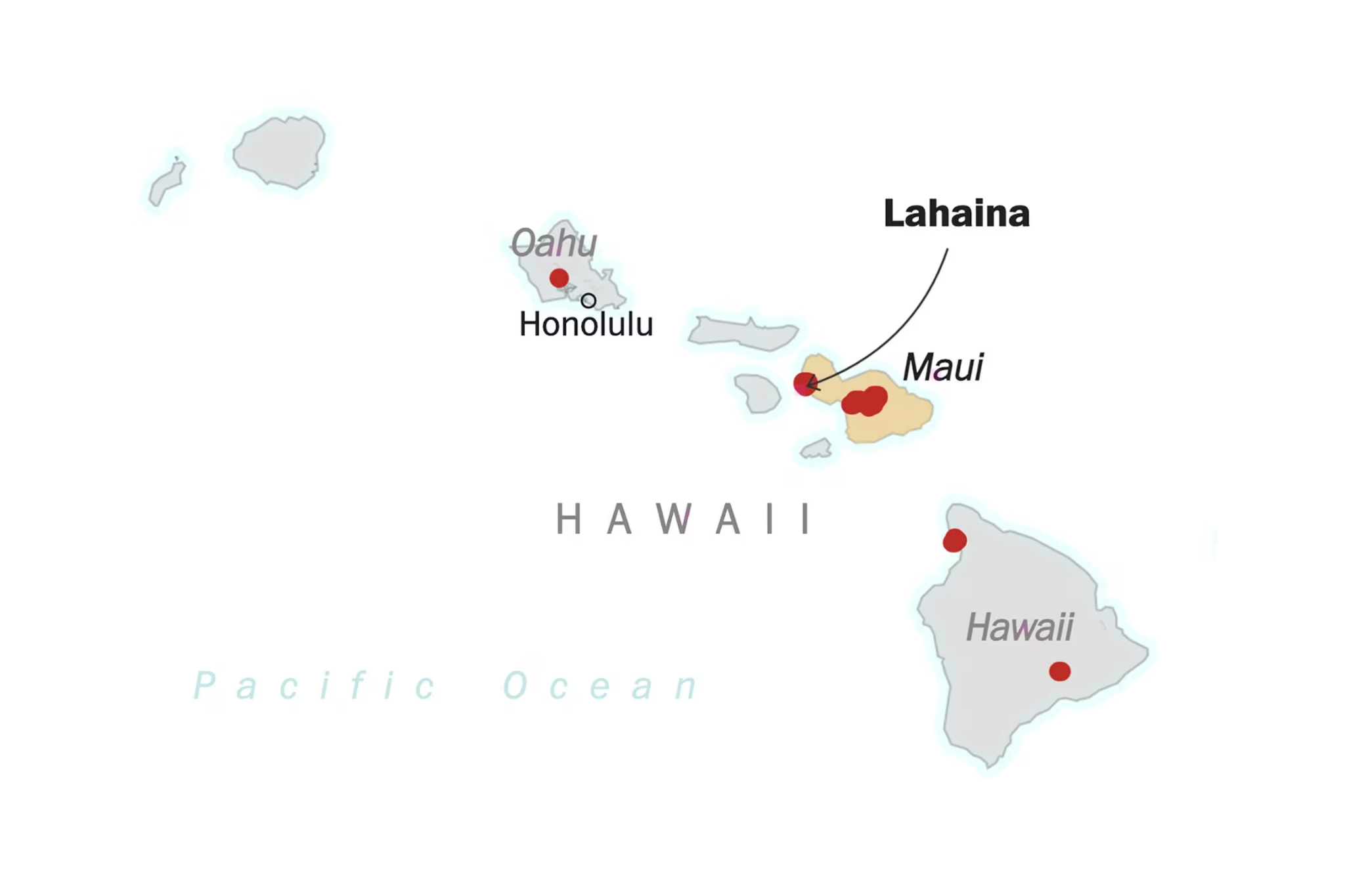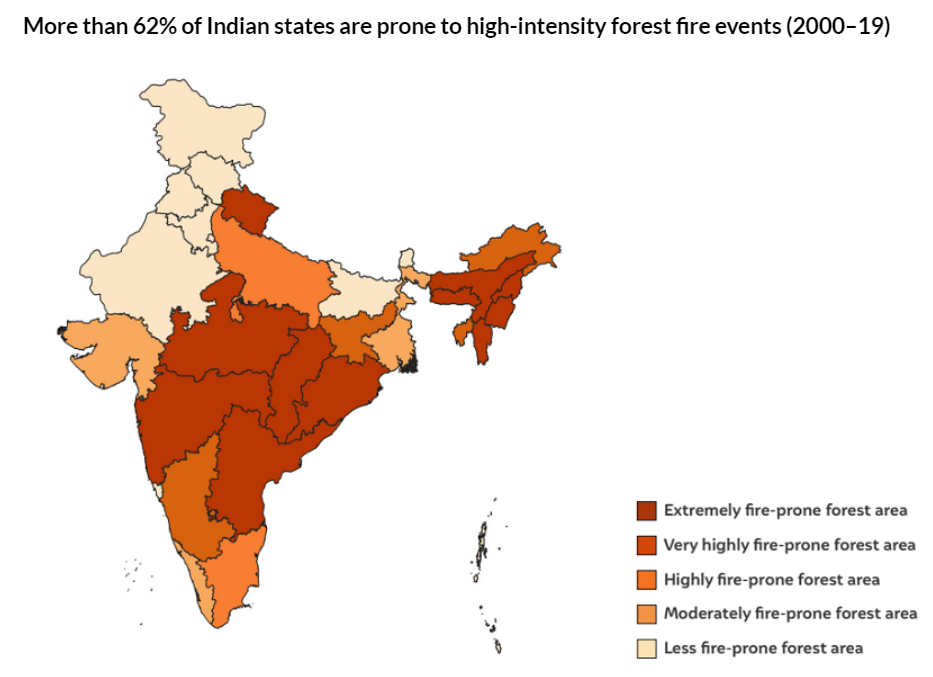Biodiversity & Environment
Large-Scale Wildfires in Hawaii
- 16 Aug 2023
- 11 min read
For Prelims: Large-Scale Wildfires in Hawaii, Wildfires, Volcanoes, Climate Change, Hurricane, El Nino, Council of Energy, National Action Plan on Climate Change.
For Mains: Wildfires, Causes and Impact. Wildfire Mitigation Strategies.
Why in News?
Recently, Hawaii has been grappling with extensive Wildfires that have wreaked havoc across the state.
- The situation has highlighted the significance of hazard mitigation plans and the identification of vulnerable areas, like Lahaina and West Maui communities, where frequent wildfire ignitions and a large number of at-risk buildings were identified in Maui County's plan last updated in 2020.
What caused such a Severe Wildfire in Hawaii?
- Flash Droughts:
- Dry weather combined with strong winds from a passing hurricane played a significant role in fueling the blaze. These conditions, known as "Flash Droughts," involve rapid moisture evaporation from the atmosphere, creating ideal conditions for fire spread.
- Maui is home to one of the six active Volcanoes of Hawaii. Most of Maui was experiencing severe drought, so the dry land, with dry non-native grasses and vegetation, was ready fuel for fires.
- These fed the fires and helped them spread.
- Dry weather combined with strong winds from a passing hurricane played a significant role in fueling the blaze. These conditions, known as "Flash Droughts," involve rapid moisture evaporation from the atmosphere, creating ideal conditions for fire spread.
- Anthropogenic and Climate Change:
- Climate change has increasingly been linked to the rising occurrence of devastating forest fires globally and Hawaii's wildfire outbreak is likely not an exception.
- As temperatures rise and air becomes warmer due to climate change, the conducive conditions for storms and wildfires are amplified.
- Furthermore, the historical land use practices of cultivating irrigated pineapples and sugar cane gave way to invasive, fire-prone grass species as these industries declined.
- This transition has contributed to the vulnerability of the land to rapid fire spread.
- The Winds of Hurricane Dora:
- The fire in Hawaii started in the wild and was carried by the wind that was blowing at almost 100 kmph.
- The winds have their origins in Hurricane Dora, an unusually strong storm in the Pacific Ocean.
- Hundreds of miles away from Hawaii, Hurricane Dora did not hit Hawaii. Instead, the islands were caught between high and low pressure zones due to the hurricane, which resulted in the winds fanning the flames and making these difficult to control.
- The fire in Hawaii started in the wild and was carried by the wind that was blowing at almost 100 kmph.
What are the Key Facts About Hawaii?
- Hawaii sits over 2,000 miles west of California in the Pacific Ocean, comprising a diverse and unique ecosystem.
- It is the 50th and youngest state of the United States.
- Renowned for its stunning natural beauty, Hawaii consists of eight main islands formed by volcanic activity.
- The state's capital is Honolulu.
- With a rich cultural heritage influenced by Polynesian, Asian, and American cultures, Hawaii boasts a vibrant and diverse society.
- The islands offer a variety of landscapes, from lush rainforests to volcanic landscapes, making it a haven for outdoor enthusiasts.
- The archipelago is famous for its hula dance, luaus, and traditional ukulele music. Hawaii's unique flora and fauna include endangered species like the Hawaiian monk seal and green sea turtle.
What are Wildfires?
- About:
- Wildfires, also known as forest fires or bushfires, are uncontrolled fires that rapidly spread across vegetation, including forests, grasslands, shrublands, and other natural landscapes.
- They can be caused by both natural factors, such as lightning strikes, and human activities, including discarded cigarettes, campfires, power lines, and intentional acts.
- Types of Wildfires:
- Crown Fires: They burn trees up their entire length to the top. These are the most intense and dangerous wildland fires.
- Surface Fires: They burn only surface litter and duff. These are the easiest fires to put out and cause the least damage to the forest.
- Ground Fires: Sometimes called underground or subsurface fires occur in deep accumulations of humus, peat and similar dead vegetation that become dry enough to burn.
- These fires move very slowly, but can become difficult to fully put out, or suppress. Occasionally, especially during prolonged drought, such fires can smoulder all winter underground and then emerge at the surface again in spring.
- Causes of Wildfires:
- Human Causes:
- Human acts of carelessness such as leaving campfires unattended and negligent discarding of cigarette butts result in wildfire disasters.
- Accidents, deliberate acts of arson, burning of debris, and fireworks are the other substantial causes of wildfires.
- Natural Causes:
- Lightning: A fairly good number of wildfires are triggered by lightning.
- Volcanic eruption: Hot Magma in the earth’s crust is usually expelled out as lava during a volcanic eruption. The hot lava then flows into nearby fields or lands to start wildfires.
- Temperature: High atmospheric temperatures and dryness offer favorable conditions for a fire to start.
- Climate change: It is causing a gradual but highly significant increasing trend in surface air temperatures, and it leads to record-breaking extremes in many areas when it interacts with the normal periodic warming associated with an El Nino.
- Human Causes:
How Vulnerable is India to the Wildfires?
- The forest fire season normally extends from November to June in India.
- A report by the Council of Energy, Environment and Water (CEEW) has noted:
- A tenfold increase in forest fires over the past two decades and says more than 62% of Indian states are prone to high-intensity forest fires.
- Andhra Pradesh, Odisha, Maharashtra, Madhya Pradesh, Chhattisgarh, Uttarakhand, Telangana, and the Northeastern states are most prone to forest fires.
- Mizoram has seen the highest incidence of forest fires over the last two decades, and 95% of its districts are forest fire hotspots.
- The ISFR (India State of Forest Report) 2021 estimates that more than 36% of the country’s forest cover is prone to frequent forest fires, 6% is ‘very highly’ fire-prone, and almost 4% is ‘extremely’ prone.
- Also, An FSI study has found that nearly 10.66% area under forests in India is ‘extremely’ to ‘very highly’ fire prone.
What are the Government Initiatives to Tackle Wildfirtes?
- National Action Plan for Forest Fires (NAPFF): It was started in 2018 with the goal of reducing forest fires by informing, enabling, and empowering forest fringe communities and incentivizing them to collaborate with state forest departments.
- National Mission for Green India (GIM): Launched under the National Action Plan on Climate Change, the GIM aims to increase forest cover and restore degraded forests.
- It promotes the use of community-based forest management, biodiversity conservation, and sustainable forest practices, which contribute to preventing forest fires.
- Forest Fire Prevention and Management Scheme (FFPM): FFPM is implemented by the FSI under the MoEF&CC. It aims to strengthen the forest fire management system by utilizing advanced technologies such as remote sensing.
- It is the only government-sponsored programme dedicated to assisting states in dealing with forest fires.
What are the Wildfires Mitigation Strategies?
- Create Fire Breaks: Fire breaks are areas where vegetation has been removed, creating a gap that can slow or stop the spread of a fire.
- Monitor and Manage Forests: Monitoring forests and managing them appropriately can help prevent fires from starting or spreading.
- Early Detection and Rapid Response: Early detection of a forest fire is critical for effective mitigation.
- The Forest Survey of India (FSI) is using satellite imaging technology (like MODIS) to analyse forest fire affected areas and boost prevention.
- Fuel Management: Reducing the accumulation of dead trees, dry vegetation, and other combustible materials through activities such as thinning and selective logging.
- Firewise Practices: Safe practices must be adopted in areas near forests viz. factories, coal mines, oil stores, chemical plants and even in household kitchens.
- Practice Controlled Burning: Controlled burning involves setting small fires in a controlled environment.
Conclusion
- The devastating wildfires in Hawaii, particularly on Maui island, are a consequence of a combination of climate-related factors, historical land use changes, and emergency response considerations.
- These fires underscore the broader issue of the increasing frequency and severity of wildfires around the world due to climate change.
- The destruction of culturally significant sites adds another layer of tragedy, as the loss of historical and ancestral connections resonates deeply with the affected communities.








